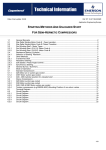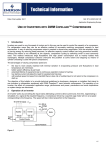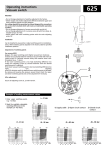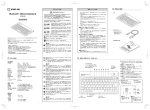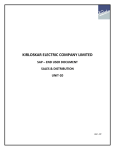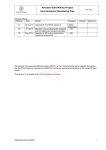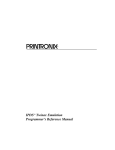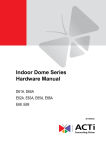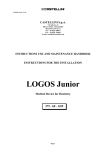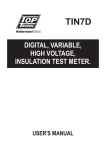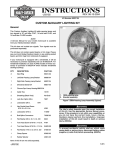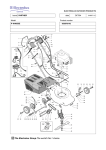Download Technical Information - Emerson Climate Technologies
Transcript
Technical Information Date of last update: Jul-05 Ref: D7.8.2/0705/E Application Engineering Europe DISCHARGE TEMPERATURE PROTECTION ON DWM COPELAND SEMIHERMETIC COMPRESSORS 1 General remarks on protection systems for DWM Copeland refrigerant-cooled compressors In refrigeration plants unforeseen conditions or erroneous design can lead to the breakdown of the compressors. The compressor manufacturer, therefore, endeavours to prevent by appropriate devices a continuous operation at conditions, which would ultimately lead to a failure. For this purpose such protective devices as oil pressure safety control and motor overload protection were introduced. The use of these components has led to a substantial reduction in compressor failures. Tests on compressors have shown, however, that also by too high discharge gas temperatures a considerable number of irregularities and failures can be caused. Electronic components, which are available on the market at competitive prices in ever increasing quantity, have made it possible to develop systems that fulfil the required technical and economical conditions. 2 Causes for too high discharge gas temperatures To avoid the occurrence of too high discharge gas temperatures, attention must be paid to unconditional observation of the known operational limits for both the various compressors and the refrigerants used. This requires devices such as high- and low-pressure switches. For refrigeration plants that work to varying evaporating and condensing temperatures, the high pressure safety switch must be set to the condensing temperature which is relative to the highest evaporating temperature and therefore, higher loads on the air-cooled condensers. In the event of the evaporating temperature falling rapidly and the condensing temperature being required to be held at corresponding low values, this is not possible due to the setting of the high-pressure safety switch for high load. A possible solution would be the dimensioning of the condenser in such a way that the necessary condensing temperature is maintained even at high evaporating temperatures. This, however, is often not desirable for economical reasons. It follows that at lower evaporating temperatures, the required maximum condensing temperature permitted for the compressor can often not be guaranteed, since the high-pressure safety switch had to be set to a higher value. When the condenser is fouled or restricted, the described process is even more accelerated and the operation of the compressor is no longer permissible, i. e. the discharge gas temperatures are too high. Examples when too high discharge gas temperatures occur cannot all be mentioned in detail, but other cases, in which the operational limits cannot be held, are briefly mentioned below. The discharge gas temperature will become inadmissible high when: 1) Excess of admissible condensing temperature by fouling of the condenser and consequential incorrect setting of the high pressure safety switch (as described in detail above). 2) Staying below the min. admissible evaporating temperature due to ice formation on the evaporator and incorrect setting of the low pressure switch. 3) Staying below the min. admissible evaporating temperature, because the low pressure switch has to be set low for pump down cycles. 4) Repetitive longer lasting excess of permissible suction gas temperature after defrosting. 5) Excess of permissible suction gas temperature with too high ambient temperature at the evaporator. 6) Excess of permissible suction gas temperature with application of the hot gas bypass controller with liquid injection. After injection is, for example, not working properly. 1/6 Technical Information D7.8.2/0705/E 7) Solenoid valve between suction and discharge side for pressure balance does not work properly, resulting in high suction gas temperature. 8) Damaged gasket between suction and discharge chamber in the cylinder head. 9) In particular with refrigerant-cooled compressors, the motor temperature and therefore the suction gas temperature downstream of the motor can rise very high at too high voltages and low evaporating temperatures. Consequently, the discharge gas temperature will also rise inadmissible high. 10) Failure of the auxiliary fan for cylinder head cooling. 11) Inadmissible high oil temperatures in the crankcase, caused for example, by constantly recycling of oil and discharge gas from a non shutting float valve in the oil separator. The problems listed under items1) to 11) can in many cases be adequately overcome by corresponding design of the refrigeration plant, in particular with plants that work at steady state conditions. If, however, there should be a possibility of varying conditions or conditions which cannot be foreseen at the design stage of the plant, then the consequences of the problems discussed can be avoided by the provision of the discharge temperature protection. As already indicated in item 9), the exceeding of the permissible discharge gas temperature happens more often on refrigerant-cooled compressors than on air- or water-cooled compressors. Therefore, the protection systems were developed for refrigerant-cooled compressors. 3 Consequences of too high discharge gas temperatures The following is a summary of the problems caused by too high discharge gas temperatures, although not necessarily complete: 1) Since compressors of the usual design are not intended for oil-free operation, the oil for the lubrication of the compressor can get into the plant via the discharge side. Thus the oil is subjected to the high discharge gas temperatures. If these become too high, then so called "cooking" occurs (heating of oil under exclusion of air). The coke is deposited e. g., on the valve plate, in the oil channels, oil filters, etc., and a progressive wear process occurs. Further blockages and constrictions arise, and therefore, too small oil circulation within the compressor; as a consequence of this a worse cooling effect, temperature rise and further cooking. Due to the ever rising temperature and, therefore, oil thinning, especially within the cylinder area, the oil is losing its lubricating property and damage to the piston path or even seizing of the piston will eventually lead to the failure of the machine. 2) Furthermore, too high discharge gas temperatures have negative consequences on the stability of the refrigerants used in the compressor (refrigerants, e. g. R134a, R407C, R404A and R22). The temperature at which the first traces of dissociation of R22 are noticeable, is e. g. 288°C, when R22 is heated in a hermetically sealed quartz tube. This value, however, will be even less, since the refrigerant in refrigeration plants is constantly in touch with steel, copper and other elements. 3) It can be noticed, that the problems listed under items 1) and 2) occur frequently simultaneously, in particular since the chemical reaction time approximately doubles at every 10°C temperature rise. This leads then directly to chemical reactions of the oil with the refrigerant and the compounds extracted from sealants and insulation material. Thus pollutants of various forms, among them acids, are formed within the system. 2/6 Technical Information 4 4.1 D7.8.2/0705/E Operation of the discharge temperature protection Location of the discharge temperature sensors Previously plant manufacturers have frequently used thermostats for the prevention of too high discharge gas temperatures, which were installed in the discharge line immediately downstream of the discharge shut-off valve. These thermostats are able to protect the compressor adequately, if the signal setting is properly selected and at relatively constant operation, but they cannot offer adequate protection at varying operational conditions. The highest temperature of the discharge gas occurs within the gap of the discharge valve immediately at the valve gap. Oil and refrigerant are subjected to this temperature. The temperature of the discharge gas, measured on the one hand at the discharge valve in the valve plate and at the other at the discharge piping, will deviate to a varying degree, dependent on the refrigerant used, cooling method and compressor type. A thermostat installed in the discharge line must have a relatively low setting point, if it is to protect the compressor from a too high discharge gas temperature to avoid possible causes of trouble. It follows that the range of application for the compressor is reduced, i. e. the thermostat reacts, even though there is not any excess discharge gas temperature at the valve gap. Any discharge temperature protection must therefore monitor the discharge gas temperature directly at the discharge reed in the valve plate of the compressor, in order not to reduce the range of operation of the compressor. The discharge temperature sensors developed by Copeland can be mounted at a suitable position in the cylinder head. The cylinder heads have holes in the positions shown in the illustrations which are closed by plugs (1/8” NPTF thread). After removal of these plugs the appropriate discharge temperature sensors can be mounted according to table 2 by using putty which is resistant to refrigerants. CAUTION If the compressor is under pressure (refrigerant or Nitrogen), then this must be released first. 4.2 Installation of the discharge temperature sensor in refrigerant-cooled compressors D4S, D6S and D8S With compressors D4S, D6S and D8S the sensors are screwed into the cylinder head at the discharge side (standard delivery supply) after removal of the plug. High-pressure safety switches have to be connected, therefore, at other suitable positions. Since the discharge reeds are arranged differently for the various compressor models, the discharge temperature sensors must also be installed correspondingly. The discharge temperature sensors have furthermore different lengths (see spare parts list) for adjustment to the various points of installation. Marking is carried out by giving the DWMC Ident.-No. The discharge gas temperature is monitored by means of a sensor, similar to the thermistor overload protection systems. It is selected in such a manner that the resistance changes considerably when the max. admissible discharge gas temperature is reached, which has been experimentally established by Copeland. The construction of the entire discharge temperature sensor has been designed in such a way that it is 100% leak proof. The subsequent installation in compressors, which already have holes for screwing in the sensor (see fig. 1 to 3 and table 1), is still possible even at the site. If physical damages should occur, caused e. g. by transport, then the entire discharge temperature sensor must be exchanged and substituted by another according to table 2 (sensor length "L" must be unconditionally observed). The 4-cylinder compressors require two sensors, 6-cylinder compressors three sensors and 8-cylinder compressors 4 sensors. In other words: one sensor is required for each cylinder head. If there is any fault in only one cylinder head, then the compressor is also switched off. 3/6 Technical Information Figure 1: D4S*-compressor D7.8.2/0705/E Figure 2: D6S*-compressor 1 Discharge temperature sensor 2 Plug high pressure connection Figure 3: D8S*-compressor D4S* (Fig. 1) D6S* (Fig. 2) D8S* (Fig. 3) 2 x required 3 x required 4 x required 1/8” -27 NPTF 1/4” -18 NPTF 1/4” -18 NPTF Table 1: Remarks to figures 1 to 3. Length L mm NAT 1) D4SA, D4SJ, D4SF Number of sensors 2 D6SJ, D6SA, D6SK 3 D8SJ, D8SK 4 D4SH, D4SL, D4ST 2 D6SH, D6SL, D6ST 3 D8SH 4 Compressor °C Length of sheating mm Length of cable mm 50 155 700 850 25 145 700 850 Table 2: Sensor features 1) NAT = nominal response temperature 4.3 Construction of the discharge temperature sensor Figure 4: Discharge gas sensor construction 1 Ident-Number 6 Corrugated hose 10 mm diameter 2 Hexagonal Nut 19 mm 7 Cable 0,75 mm 3 Thread 1/8”-27 NPTF 8 Tin-plated 4 Sensor 9 “L” varies according to the compressor model 5 PG 9 2 Table 3: Legend to figure 4 4/6 Technical Information 4.4 D7.8.2/0705/E Release module for discharge temperature sensors The thermistor built into the discharge temperature sensor assembly changes its resistance at the max. admissible temperature which has been experimentally established by Copeland. This change in resistance must be monitored by an electronic release module, supplied by Copeland, which is installed in e. g., the control panel of the refrigeration plant. Figure 5: Release Module INT 69 V The release module has a reset lock, which must be reset after the correction of the fault. Release modules without a reset lock may not be used, since otherwise there will be a too high switching frequency in the event of a fault giving too high discharge gas temperatures. The release module with reset lock can also be used in conjunction with the electronic motor overload protection system VW. Both systems, therefore, require only one release module with reset lock. However, the compressor will also be shut down at short-time faults, that relate only to the driving motor (e.g. 2-phase operation), and until the reset lock has been actuated. With two release modules being used, whereby one unit is used for motor protection without reset lock, this problem does not arise. After the external electrical fault has been corrected, the operation can be continued. A further disadvantage of the use of only one release module with reset lock is, the difficulty of establishing at subsequent investigation the cause of the fault, which protection device (thermistor) was the cause of the shut down. The application of two separate release modules, one without reset lock for the compressor motor and one with reset lock for the discharge temperature sensor is, therefore, preferable. For the motor overload protection system VS two release modules are necessary, one unit for motor protection and a further one for the discharge temperature sensor. The system VS cannot be used in conjunction with the discharge temperature sensor. 4.4.1 Technical data for the release module type INT 69 V (reset lock) Control circuit voltage: Voltage tolerance: Admissible ambient temperature: Protection: Terminals: Switch load: Switch load: Continuous current: Orientation of installation: 4.4.2 220-240 V 40-60 Hz +/-10% -20°C to +50°C IP 55 max. 4.0 mm2 at cos phi= 0.3-1 max. starting current 20 Amps at 220 V permiss. switch-off current: 3 Amps max 5 Amps any Function The release module has an electrical reset locking device which is actuated after shut-off by the sensor and prevents an automatic switching on after cooling down. On "no mains voltage" the built-in relay switches off, i.e. it moves into zero position (11 + 12 closed). At voltage return, it is switched on again (11 + 14 closed), if there are no faults in the measuring circuit. The reset lock can be overridden by a short-term interruption of the voltage by means of the reset button, which has to be installed by the customer. The unit is, therefore, also re-set at very other kind of voltage interruption. For continuous operation of the plant it is necessary therefore to ensure a continuous stable voltage. Operational interruptions of the voltage, e. g. by thermostats in series would cause an inadmissible resetting, without remedy of the actual fault. 5/6 Technical Information 5 5.1 D7.8.2/0705/E Electrical installation of the discharge temperature protection Terminal diagram, release module Figure 6: Terminal diagram L Control voltage 220-240 V 50 Hz S2 Reset button N Neutral Connection H1 Signal lamp “Fault” 1+2 Sensor connection T PTC sensor (resistance of one thermistor at 20°C is about 30 and 250 Ohms (measuring voltage 3 V max.) 12 Alarm connection X Additional terminal box 14 Control circuit connection A8 Release module for discharge temperature protection Table 4: Legend to figure 6 If compressors have been supplied by Copeland, which can equipped with corresponding sensors (please indicate on order), then the sensors are attached to the cylinder head and the connection cables are not installed in the terminal box of the compressor. Therefore, connection cables between the sensor and the release module must be intalled within the scope of the electrical installation. Since with the 4, 6 and 8 cylinder compressors the sensors (thermistors at the cylinder head) are in series, the provision of an additional terminal box near the compressor is recommended, in which the connection in series can then be carried out. 5.2 Electrical data for the discharge temperature sensor and functional commission check The sensors are to be connected in series, if necessary by using an additional terminal box, at the release module. The leads must be twisted together, so that no fault voltages are induced. The lead resistance for both leads should not exceed 2.5 Ohms. The resistance of the one thermistor in the discharge temperature sensor is 250 to 300 Ohms below the nominal switch temperature. Resistance measurements must only be carried out at 2.5 V measuring voltage. If the measurements result in much higher values, even though the temperature at the thermistor is approx. at ambient room temperature, then the sensor is faulty and must be replaced. 5.3 Functional commissioning checks and fault finding at the release module Since the discharge temperature protection works in the same manner as the motor overload protection with thermistors system VW, a check can be carried out according to descriptions in the Technical Information "Motors for semi-hermetic compressors" (D7.9.1). One only has to watch the reset lock is existent in the release module. During the following measurements the outlet of terminal 14 must be removed and the control voltage laid on. a) Control voltage between terminal L- N, 11 - N, resp., to be measured. The value must be 220240 V +/-10% AC. No DC to be used. b) After the outlets have been removed from contacts 1 and 2, the control voltage must be measureable between terminal N and 12, - fault indicator lamp is on. If this is not the case, then there is a fault in the release module. c) If terminals 1 and 2 are bridged (use wire for short circuit), then control voltage must be measureable between terminal N and 14 after depressing of the reset button, - fault indicator lamp is off. If this is not the case, then there is a fault in the release module. NOTE: The voltage should be switched off between the various tests, in order to avoid short circuits and accidental touching of conductors. Information in this document are subject to change without notification. 6/6







